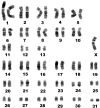X monosomy in the endangered Kiso horse breed detected by a parentage test using sex chromosome linked genes and microsatellites
- PMID: 30473577
- PMCID: PMC6361659
- DOI: 10.1292/jvms.18-0253
X monosomy in the endangered Kiso horse breed detected by a parentage test using sex chromosome linked genes and microsatellites
Abstract
A routine parentage test as part of a conservation program for Kiso horses identified a possible sex chromosome anomaly in a 7 months-old filly because of an aberrant result using LEX3, an X-linked marker. We then analyzed X-linked markers (LEX26, TKY38, and TKY270), Y-linked markers (Eca.YH12, Eca.YM2, Eca.YA16, and the sex-determining region Y gene), and an X/Y marker (Amelogenin gene). This analysis demonstrated that the filly had not inherited an X chromosome from her sire. A karyotyping analysis confirmed that the filly was 63,XO. As it was suspected that the horse would be sterile, we avoided using the horse as a broodmare; the information should also serve to prevent unnecessary conflict between owners transferring and receiving the horse.
Keywords: Kiso horse; XO monosomy; parentage test.
Figures
References
-
- Demyda-Peyrás S., Anaya G., Bugno-Poniewierska M., Pawlina K., Membrillo A., Valera M., Moreno-Millán M.2014. The use of a novel combination of diagnostic molecular and cytogenetic approaches in horses with sexual karyotype abnormalities: a rare case with an abnormal cellular chimerism. Theriogenology 81: 1116–1122. doi: 10.1016/j.theriogenology.2014.01.040 - DOI - PubMed
-
- Kakoi H., Nagata S., Kurosawa M.2001. DNA typing with 17 microsatellites for parentage verification of racehorses in Japan. Anim. Sci. J. 72: 453–460.
Publication types
MeSH terms
LinkOut - more resources
Full Text Sources
Research Materials



